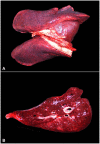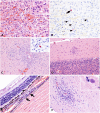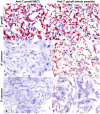Pathologic and immunohistochemical findings in an outbreak of systemic toxoplasmosis in a mob of red kangaroos
- PMID: 33739178
- PMCID: PMC8120092
- DOI: 10.1177/10406387211001869
Pathologic and immunohistochemical findings in an outbreak of systemic toxoplasmosis in a mob of red kangaroos
Abstract
Toxoplasma gondii is a zoonotic protozoan pathogen that infects many endothermic vertebrates, including humans; the domestic cat and other felids serve as the definitive host. Macropodids are considered highly susceptible to toxoplasmosis. Here, we describe the clinical, pathologic, and immunohistochemical findings of an outbreak of systemic toxoplasmosis in a mob of 11 red kangaroos (Macropus rufus), with high morbidity (73%) and mortality (100%) rates. Affected animals had either severe and rapidly deteriorating clinical conditions or sudden death, which was correlated with widespread necrotizing lesions in multiple organs and intralesional T. gondii organisms identified via MIC3-specific immunohistochemistry and confirmed by REP529-specific rtPCR. Quantification of parasites demonstrated the highest parasite density in pulmonary parenchyma compared with other tissues. Our study highlights the continued importance of this severe condition in Australian marsupials.
Keywords: Apicomplexa; Toxoplasma gondii; histopathology; immunohistochemistry; red kangaroos; toxoplasmosis.
Conflict of interest statement
Figures





Similar articles
-
Toxoplasmosis and genotyping of Toxoplasma gondii in Macropus rufus and Macropus giganteus in Argentina.Vet Parasitol. 2010 Apr 19;169(1-2):57-61. doi: 10.1016/j.vetpar.2009.12.004. Epub 2009 Dec 16. Vet Parasitol. 2010. PMID: 20045255
-
Fatal Toxoplasmosis in Red Kangaroos (Macropus rufus) in East China.Pathogens. 2025 Feb 19;14(2):202. doi: 10.3390/pathogens14020202. Pathogens. 2025. PMID: 40005577 Free PMC article.
-
Toxoplasmosis in black-faced kangaroos (Macropus fuliginosus melanops).Vet Parasitol. 1988 Dec;30(2):97-105. doi: 10.1016/0304-4017(88)90156-2. Vet Parasitol. 1988. PMID: 3245110
-
Recent aspects on epidemiology, clinical disease, and genetic diversity of Toxoplasma gondii infections in Australasian marsupials.Parasit Vectors. 2021 Jun 5;14(1):301. doi: 10.1186/s13071-021-04793-4. Parasit Vectors. 2021. PMID: 34090502 Free PMC article. Review.
-
The history of Toxoplasma gondii--the first 100 years.J Eukaryot Microbiol. 2008 Nov-Dec;55(6):467-75. doi: 10.1111/j.1550-7408.2008.00345.x. J Eukaryot Microbiol. 2008. PMID: 19120791 Review.
Cited by
-
Microbial Diversity Profiling of Gut Microbiota of Macropus giganteus Using Three Hypervariable Regions of the Bacterial 16S rRNA.Microorganisms. 2021 Aug 12;9(8):1721. doi: 10.3390/microorganisms9081721. Microorganisms. 2021. PMID: 34442800 Free PMC article.
-
Toxoplasmosis in Captive Ring-Tailed Lemurs (Lemur catta).Pathogens. 2022 Oct 3;11(10):1142. doi: 10.3390/pathogens11101142. Pathogens. 2022. PMID: 36297199 Free PMC article.
-
Epidemiology and isolation of viable Toxoplasma gondii strain from macropods.Heliyon. 2023 Mar 1;9(3):e13960. doi: 10.1016/j.heliyon.2023.e13960. eCollection 2023 Mar. Heliyon. 2023. PMID: 36938389 Free PMC article.
-
Multiple Typing Approach to Characterize Toxoplasma gondii Strains from Captive and Livestock Species in Northern Italy Suggests the Circulation of Type-II Variants.Animals (Basel). 2024 Dec 12;14(24):3597. doi: 10.3390/ani14243597. Animals (Basel). 2024. PMID: 39765501 Free PMC article.
-
Development of a qPCR molecular diagnostic assay for the detection of kiwi Eimeria species and its application to determine tissue-specificity of species causing coccidiosis in North Island brown kiwi (Apteryx mantelli).Parasitol Res. 2025 Jul 4;124(7):77. doi: 10.1007/s00436-025-08521-0. Parasitol Res. 2025. PMID: 40610817 Free PMC article.
References
-
- Adkesson MJ, et al.. Toxoplasma gondii inclusions in peripheral blood leukocytes of a red-necked wallaby (Macropus rufogriseus). Vet Clin Pathol 2007;36:97–100. - PubMed
-
- Barry R, et al.. A probe-based real-time PCR assay for the detection of Neospora caninum in clinical samples from cattle. Vet Parasitol 2019;269:2–6. - PubMed
-
- Basso W, et al.. Toxoplasmosis in captive Bennett’s wallabies (Macropus rufogriseus) in Argentina. Vet Parasitol 2007;144:157–161. - PubMed
-
- Bermúdez R, et al.. Toxoplasmosis in Bennett’s wallabies (Macropus rufogriseus) in Spain. Vet Parasitol 2009;160:155–158. - PubMed
Publication types
MeSH terms
LinkOut - more resources
Full Text Sources
Other Literature Sources
Miscellaneous

